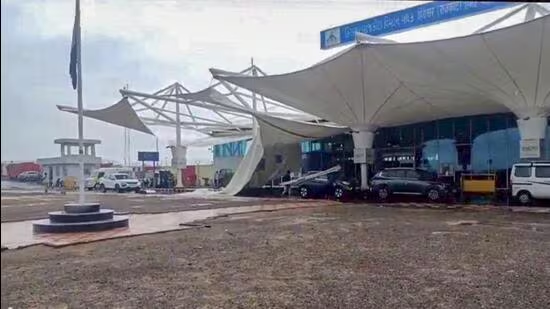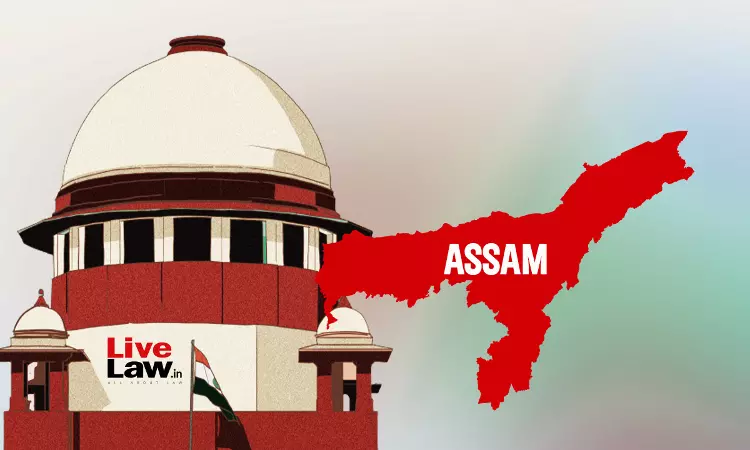In a concerning pattern, the Rajkot Airport in Gujarat has become the latest Indian airport to suffer a canopy collapse, marking the third such incident in less than a week.
The incident occurred on June 29th, 2024, as heavy rainfall hit the region. A section of the canopy covering the passenger pickup and drop-off areas outside the airport terminal suddenly gave way, with no reported injuries or casualties.
This follows a tragic event at New Delhi’s Indira Gandhi International Airport Terminal-1 on June 28th, where a portion of the canopy collapsed, resulting in one fatality and multiple injuries. Earlier in the week, a similar incident was reported at Madhya Pradesh’s Jabalpur airport, raising serious questions about the resilience of India’s airport infrastructure.
The Rajkot Airport, a greenfield facility built by the Airport Authority of India (AAI) and inaugurated by Prime Minister Narendra Modi just a year ago in July 2023, has now been the site of this latest infrastructure failure. Officials have stated that the canopy broke during maintenance work to remove accumulated water, suggesting potential design or construction flaws.
Delhi airport as the roof collapsed burier cars kill

“A detailed report has been sought to understand the cause of the collapse and to prevent such incidents in the future,” an anonymous government official told the Hindustan Times. The incident has sparked concerns about the quality of construction and maintenance at recently developed infrastructure projects in India.
The Jabalpur Airport Incident: Allegations of Corruption
In a separate incident, a section of the tensile roof canopy at Dumna Airport’s newly expanded terminal in Jabalpur, Madhya Pradesh, collapsed on June 29th following heavy rains. This had led to allegations of corruption from the opposition Congress party.
The Jabalpur airport was inaugurated by Prime Minister Narendra Modi just three months ago. The Airport Authority of India (AAI) in Jabalpur issued a statement, citing “technical reasons” for the incident and assuring a comprehensive investigation.
Rajiv Ratan Pandey, the Director of Jabalpur Airport, explained that the fabric canopy was built for ‘decorative purposes” and that the collapse was caused by the accumulation of rainwater. However, the opposition has seized on this incident to level accusations of corruption in the construction and maintenance of the new airport facilities.
These back-to-back incidents at the newly inaugurated airport have raised serious concerns about the quality and oversight of infrastructure development in India, particularly in the aviation sector.
Extreme Weather and Infrastructure Resilience
The spate of canopy collapses at Indian airports has coincided with widespread rainfall across the country, triggered by a cyclonic circulation over the southern part of Gujarat. The India Meteorological Department (IMD) has issued a ‘yellow alert’ for the region, warning of heavy showers on June 29th and in the coming days.
“The cyclonic circulation, previously over central Gujarat, has shifted southward, extending up to 4.5 km above mean sea level, “the IMD bulletin stated. “This shift is expected to sustain active monsoon conditions in Gujarat during the forecast period.”
The heavy rainfall and the resulting infrastructure failure have raised concerns about the resilience of India’s airport facilities in the face of extreme weather events, which are expected to become frequent and severe due to the impacts of climate change.
Calls for Comprehensive Infrastructure Review
The recent spate of incidents has promoted calls for a comprehensive review of the structural integrity and maintenance practices at airports across India. Union Minister of Civil Aviation, Ram Mohan Naidu Kinjarapu, stated that he was “Personally monitoring the roof collapse incident at T1 Delhi Airport” and had advised airlines to assist affected passengers.
The Bharatiya Janata Party (BJP) has also responded to the Rajkot incident, with the party’s IT cell chief, Amit Malviya, stating that the collapse was due to “heavy wind and rain” and noting a failure of infrastructure. However, Malviya acknowledged that the Ministry of Civil Aviation (MoCA) had ordered a security review of all small and big airports in the country.
The opposition Congress party, on the other hand, has criticized the government, posting on the social media platform X (formerly Twitter): “Third airport accident in three days. Now the picture of ‘development’ has emerged in Rajkot. This airport was inaugurated by Narendra Modi – just 1 year ago.”
These incidents have highlighted the urgent need for a thorough examination of the construction quality, maintenance practices, and overall resilience of India’s airport infrastructure, particularly in the face of extreme weather events. Policymakers and aviation authorities must prioritize addressing these concerns to ensure the safety and reliability of the country’s air travel network.
In conclusion, the collapse of the canopy at Rajkot Airport, following similar incidents at Delhi and Jabalpur, has raised serious questions about the quality and maintenance of India’s airport infrastructure. As the country grapples with the impacts of climate action investigation, the root cause of others is the failurere and implement comprehensive measures to prevent such occurrences in the future. The safety and reliability of India’s air travel network must be the top priority.










